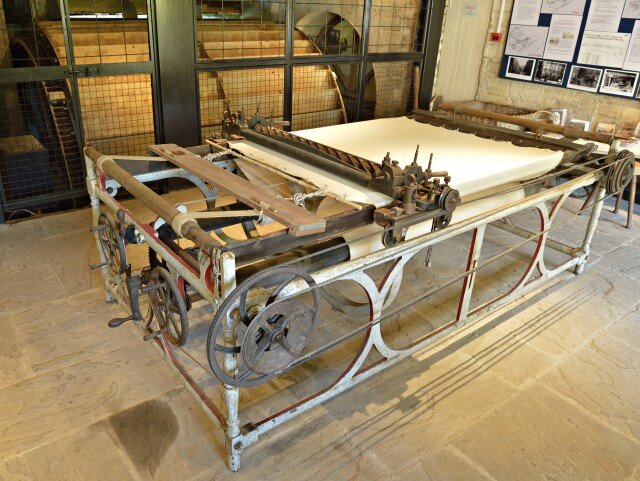The Cross Cutter
Invented by John Lewis of Brimscombe Mills in 1815/18, this model has no date or maker’s name.
The Cross Cutter at Dunkirk Mill Museum
A revolutionary invention
The cutter quickly replaced shearmen, and Lewis claimed by 1829 that he had already sold thousands of them. They spread across the woollen industry internationally.
You could take 5 or 6 cuts one way, return it to the raising gig for 3 hours, and take another 5 or 6 cuts the other way. Previous cloth was considered shaggy by comparison.
The process was much quicker than by hand. It took about 2 hours to do one cut to a piece of cloth 21 yards long.
Two boys supervised by a man could work two machines.
How it worked
Imagine a rotary lawn mower. The nap is trapped briefly between the turning blades and a straight sharp blade called the ledger blade. The cloth is tensioned cross-wise with hooks in the edge (or selvedge or list) of the cloth, attaching it to a pair of leather and wood frames which could be precisely tensioned using the small rollers at the ends of the machine. The cloth is wound on to the large rollers underneath, with various controls to allow this to happen mechanically, and is tensioned. Power was provided by belting on the small fast and loose rollers, and this was transmitted to the heavy carriage to draw it steadily across the cloth, rapidly rotating the spiral cutting blades as it went. The cloth is then unhooked, wound on, re-hooked and correctly tensioned in both directions, in order to prepare the next ‘board’ for shearing.
In 1830, a machine was invented by Lewis where the cloth could be fed in continually, the ‘Perpetual’. It was not so good at close cutting, but Edwin Budding, the foreman at the Phoenix Ironworks, Thrupp, was inspired by the first of these to invent the lawn mower. It was only in the late 19th century that better machines began to be made, but the basic concept of the rotary cutter remains to this day.


